Abstract
Ensuring the sustainability of a product or a system requires a thorough evaluation of its environmental and socioeconomic impacts. In this context, one of the objectives of the EU-PRIMA SmaCuMed project is to evaluate the socioeconomic and environmental impacts of the Smart Cube system. The Smart Cube was developed for the PV-powered desalination of brackish groundwater with membrane capacitive deionization (MCDI) and low-pressure reverse osmosis (LPRO); it additionally uses smart sensors for controlled irrigation in remote agricultural areas in Morocco, as an example for the North African region. Based on the Life Cycle Sustainability Assessment approach, this paper aims to assess the environmental and economic impacts of the Smart Cube, using Life Cycle Costing (LCC) and Life Cycle Assessment (LCA) analyses for environmental evaluation. Various scenarios have been defined for both environmental and economic assessments. Based on 1 m3 of produced desalinated water, the LCC results showed that, when using the desalination technologies directly connected to the grid, the prices are lower than those obtained when it was supplied by the PV system. This is only due to the very low energy prices from the Moroccan grid (EUR 0.10/kWh). The LCC results showed that LPRO is a more cost-effective option for producing desalinated water, with a lower total cost compared to MCDI. However, LCA results indicated that LPRO has a higher environmental impact compared to MCDI. If higher water production capacity is a priority, MCDI connected to PV is the best choice, with lower carbon emission but higher overall water costs.
1. Introduction
Water scarcity is one of the major constraints threatening human development. Due to the excessive use of water in several regions around the globe, the problem of water scarcity is becoming increasingly serious [1] and is being exacerbated by climate change and urbanization. It is therefore necessary to find solutions to overcome water deficiency [2].
In agriculture, water is a primary necessity for production and plays a fundamental role in food security, with 70% of global water used for irrigation [3]. In arid and semi-arid regions, the water crisis is one of the major problems encountered in the agricultural sector [4]. The water problem is not only limited to scarcity but also extends to the degradation of water quality [5]. Thus, the implementation of effective plans and strategies and the installation of suitable methods for the restoration, management, and development of water resources remains a challenge for society, industry, and agriculture [6]. Furthermore, the development of innovative technologies, such as desalination technologies and smart irrigation systems, to treat and improve water quality and reduce water consumption towards sustainable agriculture is becoming a fundamental goal [7]. Desalination is a promising option for providing freshwater from alternative resources and meeting agricultural needs [8]. Since ancient times, desalination has been used to produce freshwater from brackish or saline water [9]. Based on the working principle, there are three main types of desalination technologies: (i) evaporation and condensation technologies that include mechanical processes such as mechanical vapor compression (MVC) and thermal processes such as multi-effect distillation (MED), multi-stage flash (MSF), thermal vapor compression (TVC), solar still distillation (SSD), humidification dehumidification (HDH), and solar chimney (SC); (ii) membrane technologies, for example reverse osmosis (RO), forward osmosis (FO), nanofiltration (NF), membrane distillation (MD), and (iii) electrochemical/-sorptive process such as electro-dialysis (ED) and capacitive deionization (CDI). RO is currently the most widespread desalination technology, followed by MSF and MED. Four types of energy can be used to run a desalination process: thermal energy, which can be provided by solar thermal or geothermal energy sources; mechanical energy; electrical energy; chemical energy [9]. For agricultural applications, desalination technologies can be an attractive and competitive solution to provide cost-effective and good-quality water in places with poor-quality water resources. Many factors determine the appropriate technology that can be used for desalination, in particular the water quality [10].
On the other hand, smart irrigation, an innovative method that combines science and technology for automatic and efficient irrigation on farms, is emerging as a promising solution for rational water management and high productivity in agriculture [4]. Smart irrigation systems include different technologies, such as sensors, computer or mobile phone applications, and automatic control devices integrated within different irrigation technologies and/or methods. Thus, weather, soil moisture, and evapotranspiration are monitored to optimize water use efficiency [11].
In view of the above, the EU-PRIMA project SmaCuMed (www.smacumed.eu; accessed on 13 February 2024) offers an integrated approach by providing a sustainable and innovative solution for groundwater desalination in the field of smart irrigation. SmaCuMed consists of the integration of a novel desalination technology—membrane capacitive deionization (MCDI) with low-pressure reverse osmosis (LPRO)—into an all-in-one “Smart Cube” system. This enables the energy-autonomous treatment of brackish groundwater while supplying smart sensor controlled irrigation in remote agricultural Mediterranean regions [12,13]. MCDI is an electrosorptive technology consisting of applying a small electrical potential using porous carbon electrodes to adsorb dissolved salts. The main advantages over other technologies are its reduced energy consumption and high water recovery. However, the main disadvantages of the MCDI are its limitation to low salinity ranges (<5 g/L) and high investment costs [14]. The LPRO, on the other hand, is a membrane desalination technology based on the well-established principle of reverse osmosis (RO). By applying high-pressure to a saline solution, fresh water permeates through its semi-permeable membrane to retain the salts. For low–mid-saline brackish water, the use of highly permeable membranes in LPRO enables a low-cost and low-energy process. However, its high energy consumption due to the use of pressure pumps up to 16 bar, its fouling potential, and its low recovery rates are some of the main issues affecting LPRO [15,16].
Nowadays, it has become necessary to evaluate the environmental and socioeconomic impacts of a product or a system in order to guarantee its sustainability. In this context, one of the objectives of the SmaCuMed project is to evaluate the socioeconomic and environmental impacts of the Smart Cube using Life Cycle Assessment (LCA).
LCA is defined as an approach for assessing the potential environmental impacts of products throughout their life cycle [17]. It provides the possibility of quantifying the impacts and identifying the aspects that most influence the environmental performance [18]. In addition, Life Cycle Cost (LCC) analysis is an economic evaluation approach to estimate the direct and indirect costs over the entire life cycle of a product [19] and to provide input to decision makers as an important part of sustainability assessment [20,21].
To date, only a handful of LCA publications have been published for both LPRO and MCDI, while comparisons of both technologies are scarce. Yu et al. (2016) [22] and Shiu et al. (2019) [23] carried out an LCA and a hotspot analysis for MCDI, identifying some electrode materials that have the most environmental impacts. Results also showed that the MCDI system has potential advantages to be an efficient water technology with low energy consumption and low energy-related environmental impacts. Another study conducted by Çetinkaya (2020) investigated the environmental impacts of MCDI technology during the removal of nitrates from water using LCA. The results showed that the MCDI system showed the greatest potential during its operational phases and that its environmental impacts mainly depended on the type of materials used in the manufacturing process; the most important environmental impact was the water consumption [24].
In another study, Shahabi et al. (2014) conducted an LCA analysis to evaluate the greenhouse gas (GHG) emissions of RO used for seawater desalination and evaluate its performance under three power supply scenarios. The results showed that renewable-energy-powered desalination systems achieve a reduction of 90% of GHG emissions compared to the plant-powered system under the grid scenario [25].
Cetinkaya et al. (2019) used the LCA approach to evaluate and compare the environmental impacts of RO and MCDI systems used for textile wastewater treatment. The obtained results concluded that MCDI is the most environmentally friendly technology [26].
Regarding LCC, Bales et al. (2021) described an agricultural economic model for the assessment MCDI technology for the desalination of brackish groundwater. Results showed that, when the salinity reduction is <2.9 dS/m, the production cost is less than USD 1.2/m3 for an orange crop [27]. According to AlMarzooqi et al. (2014), the desalination cost for RO was USD 0.35/m3, while that for CDI was USD 0.11/m3 for the case of 2000 parts per million (ppm) feed solution [14]. Several parameters can be used to determine the water production cost of a desalination technology: the energy source, the lifetime of desalination systems, the operating and capital costs, and the costs related to maintenance, membrane replacement, and chemicals [28,29].
In this study, LCA and LCC were used to evaluate the environmental impacts and economic implications of the Smart Cube implemented in an agricultural Mediterranean region in Morocco for the desalination of brackish groundwater.
2. Materials and Methods
2.1. Experimental Setup
The smart irrigation concept comprises four systems, integrated in the Smart Cube: (1) desalination, (2) energy supply (photovoltaic PV), (3) irrigation, and (4) monitoring (see Figure 1). The Smart Cube was tested in two pilot trials at two distinct locations in Morocco: Essaouira and Erfoud. An overview of the groundwater quality in both locations is given in Table 1. The produced irrigation water was divided in two target qualities (irrigation water quality 1—66%; quality 2—33% desalination of the respective feed water).
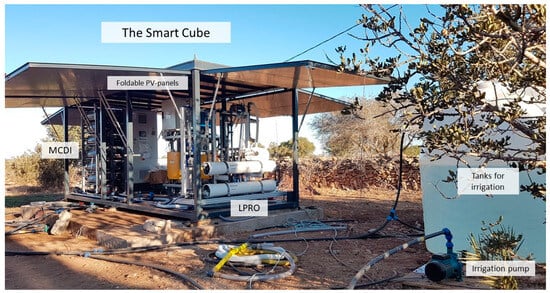
Figure 1.
The Smart Cube system: installation in Essaouira, Morocco.

Table 1.
Groundwater quality at two pilot sites Essaouira and Errachidia.
2.2. The Smart Irrigation System
Two innovative technologies were implemented in the Smart Cube: Membrane Capacitive Deionization (MCDI) and Low-Pressure Reverse Osmosis (LPRO) (see Figure 2). A detailed plant description was reported in Cañas Kurz et al. [13].
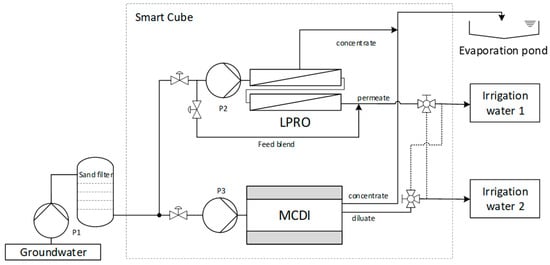
Figure 2.
Scheme of Smart Cube incl. well pump, desalination systems, and evaporation ponds.
The MCDI system (Voltea Inc. IS12-H, Dallas, TX, USA) consists of 12 electrode modules (Voltea Inc. C18) made of active carbon/carbon black and graphite current collectors, cation- and anion-exchange membranes, and a glass fiber separator. In addition, the system uses four power supply units (Power Solve, PEK300012, Newbury,
UK), a feed pump (Grundfos, CM10-3, 2.2 kW, Bjerringbro, Denmark), and a pulse pump (Salcavi Tecnik, Rimini, Italy) and air compressor (generic) for CIP cleaning. The system is controlled using a SPS Control Unit through an HMI Monitor (panel), a variable freq. converter (VFD), and a network router. Sensors included a current sensor, a voltage sensor, a temperature sensor, a pressure sensor, a flow meter, EC sensors, and an air flow sensor.
The LPRO (Schaller I.W. GmbH, RO-PVCU2000, Meckesheim, Germany) consists of two low-fouling spiral wound membrane modules made of composite polyamide (Nitto, ESPA2-LD 8040, Osaka, Japan) with a feed pump (Grundfos, CM10-3, 2.2 kW, Bjerringbro, Denmark) and a high-pressure pump (KSB Movitec VSF006-16, 4 kW, Frankenthal, Germany) to operate at pressures pmax = 15 bar. Sensors included volume flows measuring using 4 flow meters (GEMÜ 800), pressure sensor (generic), EC sensor with transmitter, and 2 manometers. Both desalination systems have a cartridge pre-filter (1 μm) for particle filtration.
The Smart Cube is powered by 19 foldable solar PV panels (Suntech Power STP405S-A72, Wuxi, China) with an output of 7.7 kWp on a total area of 38.2 m2 and a battery system consisting of 6 lithium iron phosphate-LFP batteries (BYD B-Box Premium LVS 24.0, Shenzhen, China) with a total capacity of 24 kWh, 1 inverter (Sunny TriPower 6.0-1AV, SMA, Kassel, Germany), and 3 battery inverters (SunnyIsland 6.0H, SMA, Kassel, Germany). PV panels were mounted in a “cube” metal frame with door flaps and mounting rails.
2.3. Framework for LCA and LCC Analysis and Tools
The analysis of environmental and economic impacts was conducted with Life Cycle Assessment (LCA) and Life Cycle Costing (LCC). LCA is a standardized technique according to the International Organization for Standardization (ISO) and is defined in ISO 14040 and 14044. LCA is a widely accepted tool to carry out an environmental impact analysis of products and processes [30]. The LCA conducted in this study included four phases: goal and scope definition, inventory analysis, impact assessment, and interpretation [31].
In this study, LCA was used to carry out the environmental impact assessment of GHG emissions. The framework of LCA can be appropriately adapted for the assessment of LCC.
2.4. System Boundaries and Functional Unit
In the present study, the production of irrigation water (functional unit, FU; one cubic meter (1 m3 of desalinated water)) is assessed using LCC and LCA in accordance with ISO 14040/44. The system boundary is gate-to-gate, which relates only to Smart Cube production and maintenance activities (see Figure 3). The focus of this study is the evaluation of the potential environmental impacts and economic implications along the life cycle of the Smart Cube, including desalination technologies and a PV system.
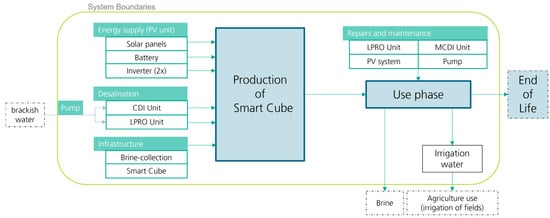
Figure 3.
System boundary of Smart Cube in this study. Green boxes: system units; blue boxes: LCA stages; dotted lines: input/outputs outside of the system boundary.
The irrigation of water in the fields, sensors, and equipment necessary for the irrigation are not included in this assessment. Transportation of the Smart Cube to the farm is not considered. End-of-life allocations are not included because of many uncertainties regarding the current and future situation in the demonstration country Morocco. For brine treatment, evaporation ponds were considered practically [13] but were not evaluated in the LCA or LCC due to lack of accurate data.
2.5. Scenarios Description
The baseline scenario for the Smart Cube is defined in Table 2 and takes into account the factors that have a direct impact on the functional unit, including daily water demand, the groundwater level, the lifetime of the Smart Cube, and the days of operation.

Table 2.
Baseline scenario for Smart Cube.
Two desalination targets of 33% and 66% of salt removal were considered for the LCC calculations as these have a direct impact on production costs through water recovery and energy consumption.
Three scenarios were described to evaluate the environmental and economic impacts in terms of CO2 emission and water production costs of the Smart Cube.
- Scenario 1—Baseline results described in the system boundaries and functional unit:
The baseline results provide a benchmark for understanding the actual environmental impacts and costs of the Smart Cube system under real conditions including the power generation from the photovoltaic (PV) system and the baseline parameters as set out in [13], as well as a comparison of each technology.
For the LCA, the volume of water processed was fixed at 20 m3/day. For the LCC, water desalination costs were based on experimental results and actual performance of the desalination plants as reported in [13]. These values are presented in Appendix A, Table A1.
- Scenario 2—Baseline results based on the use of the Moroccan electricity grid:
In the second scenario, the costs for the water desalination of the Smart Cube are calculated using the average electricity generation mix in Morocco instead of the PV system as power source (EUR 0.10/kWh [32]). The water desalination process and desalination capacity (m3/day) remain the same as in Scenario 1. Concerning LCA, baseline results are compared to the environmental impact of electricity grid mix in Morocco and alternative irrigation options including pumping with diesel and butane pumps and water delivery by truck.
- Scenario 3—Different daily production rates:
In this scenario, water costs are calculated for both MCDI and LPRO at equal daily water production rates (V = 5, 10, 20, 40, and 50 m3/day), both powered by the PV or the grid. The net flows and daily electricity demand are calculated on the basis of Scenario 1 and scaled up or down accordingly. Costs are adjusted linearly.
2.6. Life Cycle Inventory (LCI)
Data collection for the Smart Cube was carried out in close collaboration with the project partners. The data collection strategy included a literature search as well as primary and secondary data and assumptions. Technical data sheets were also revised, and, in some cases, the manufacturers were contacted. In addition, several iterations were carried out with the project partners and farmers to improve the quality of the data. In the case of missing information, generic LCA models (proxies) of comparable conditions from existing LCA models of the research institute FhG-IBP were conducted. In addition, information for the use phase was collected during the operation of the pilot plant in Essaouira and from local partners at the pilot site.
A questionnaire was sent out to the Moroccan partners to gather base information on water use, sources, and alternative irrigation options (see Supplementary Materials Table S1). Subsequently, groundwater pumping from nearby wells and transportation of water via trucks was considered as alternative irrigation options among various others.
In the case of the irrigation water delivered by trucks, the trucks are diesel-powered. The standard Euro 5 truck with payload of 5 m3 travels a maximum of 3 km. In addition, the type of diesel available in Morocco is ULSD (ultra-low sulphur diesel), where the sulphur content is 10 ppm. Furthermore, the Moroccan electricity grid mix is composed of 1.4% photovoltaic, 56% heavy fuel (oil), 6.5% solid biomass, 30% hard coal, 0.3% hydropower, 4% natural gas, and 1.7% wind power.
The selected fuel and the pumping system efficiencies were the only parameters which changed. The efficiencies of both the diesel and LPG pumping systems were set at 20% based on the efficiencies of the fuels, the generator [33] and the pump [34]. Electric pumps have minimum efficiency of 40% [35] at a groundwater depth of 20 m.
Data collected for the LCA, detailing the mass and component breakdowns for each unit of the Smart Cube system, are provided in Appendix A, including information on materials and associated maintenance intervals for each component.
The mass balance data of the different units and components show that the Smart Cube infrastructure contributes significantly to the total mass (1495 kg), followed by the MCDI unit (1029 kg), the PV power supply unit (923 kg), and the brine-collection system (872 kg). The well pump is the smallest contributor to the total mass (Appendix A, Table A2).
2.7. LCA Methodology
The results are presented in climate change (CO2-eq.) units according to the Environmental Footprint (EF) 3.0 methods made by the European Commission [32]. The calculations and the modelling of the system were carried out using the LCA for Experts (GaBi) software version 10.5.0.78 (Sphera Solutions GmbH, Leinfelden-Echterdingen, Germany) and the impact characterization factors were taken from the Life Cycle Assessment (GaBi) database version 2022.1. The impact category chosen was climate change (CO2-eq.) among the Environmental Footprint (EF) 3.0 methods. In addition, a hotspot analysis was performed to determine which components contributed to the highest environmental impacts [23].
2.8. LCC Methodology
For calculating the LCC of the Smart Cube, three main costs were taken into consideration: the investment costs (I), the replacements costs (Repl), and the maintenance costs (M). The formula below was used to summarize the gate-to-gate costs that occur in the use of the Smart Cube:
LCC = I + Repl + M
The total cost of each technology is compared based on the production capacity of desalinated water, as well as the total water cost per cubic meter [32].
Specific water costs = Volume desal. Water/LCC
Total costs calculations were carried out by taking into account capital, replacement, and maintenance/operational costs [33]. Figure 4 presents the cost breakdown structure of the Smart Cube.
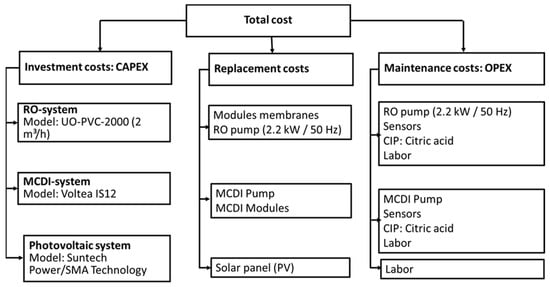
Figure 4.
Cost breakdown structure (CBS) of the Smart Cube.
3. Results
3.1. Life Cycle Impact Assessment (LCIA)
The LCIA results are divided in production and use phase. The production phase includes the infrastructure (brine treatment, CuBox (frame), and well pump), the MCDI, the LPRO unit, and the power supply system (solar, battery inverter, solar panels, and battery). Figure 5 shows the absolute values in kg CO2-eq of the different units for the production of a single Smart Cube system. The results show that the production phase of the PV solar panels, with 4403 CO2-eq, is the most significant impact of all, followed by the CuBox (frame) with 3394 kg CO2-eq.; meanwhile, 1602 kg CO2-eq. is produced by the geomembrane for the evaporation pond (brine treatment). In the case of the desalination plants, the 12 electrode modules (C 18) of the MCDI had the highest emissions at 2743 kg CO2-eq., out of a total of 4200 kg CO2-eq. for the entire MCDI unit. The general mechanical parts in the RO unit accounted for 759 kg CO2-eq. out of a total of 2175 kg CO2-eq. for the entire LPRO unit. The battery inverter had an impact of 2073 kg CO2-eq. compared to 915 kg CO2-eq. from the batteries and 187 kg CO2-eq. from the solar inverter. The total environmental impact of producing the Smart Cube is equal to an emission of 19.1 Tons of CO2-eq.
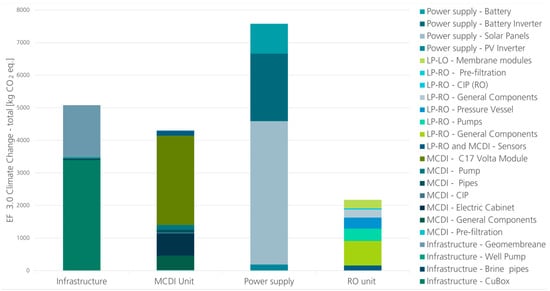
Figure 5.
EF 3.0 climate change results (Kg CO2-eq.) per system units of Smart Cube production.
During the use phase, the LCIA model considers the maintenance of the Smart Cube system such as module cleaning (cleaning in place CIP with chemicals), cleaning of PV panels, repairs of pumps and fittings, etc. The results are multiplied by the number of replacements per consumable and the one-time replacement impact. The number of replacements was derived from the expected lifetime of the Smart Cube divided by the replacement frequency of each consumable and ranges from 5 to 15 years. Note that the number of replacements or the number of consumable changes depends on the operating conditions at the sites. The conditions are based on the pilot period in Essaouira. The total impact over the life of the Smart Cube, including the use phase, is 19.7 tonnes of CO2-eq, as detailed in Figure 6.
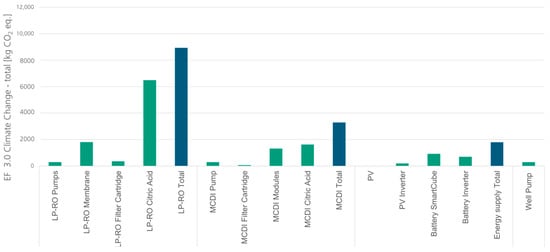
Figure 6.
Climate change results (Kg CO2-eq.) of Smart Cube use phase over 30 years (green: CO2-eq. per unit; blue: total CO2-eq. per system).
Although the RO unit has a lower impact on CO2 emissions at the time of installation, it is the one that will have the greatest impact on carbon emissions over its lifetime due to the high frequency of maintenance requirements [33].
Based on the inventory data for the production and maintenance collected in the LCA, the investment, replacement, and maintenance costs associated with the different units of the Smart Cube (LPRO unit, CDI unit, and PV unit) were collected from actual purchase values and costs incurred during operation as well as assumption and calculations (see Appendix A, Table A3). The amortization of the investment costs is based on a life span of 30 years. This includes the replacement of key components over the entire life span.
For LCC, an overview of the yearly costs for all three systems is given in Figure 7. The yearly costs totaled EUR 4751/yr for the MCDI, followed by the PV system at EUR 2722/yr, and the LPRO system with EUR 1753/yr. When comparing investment, maintenance, and replacement costs, the highest expenses were attributed to the replacement costs which ranged between EUR 742 (LPRO) and EUR 3766 (MCDI) per year. This accounted for 42% and 79% of the total yearly costs, respectively.
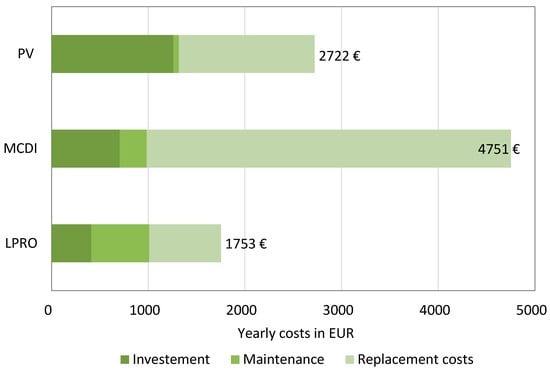
Figure 7.
Cost allocation of the different systems.
The results show that the PV unit had the highest investment costs (EUR 1260/yr) while the MCDI (EUR 705/yr) and the LPRO had the lowest costs (EUR 412/yr). The maintenance and operational costs were as low as EUR 58/yr (PV unit), which included cleaning and check-ups, and these costs were higher for the MCDI (EUR 280/yr) and the LPRO (EUR 600/yr). The maintenance work for the desalination systems included cleaning in place (CIP), chemicals used (citric acid), repairs (e.g., broken pipes, valves), pump maintenance, etc. While the MCDI required more maintenance work (in hrs/week) that increased labor costs, the higher total maintenance/operational costs of the LPRO were attributed to the greater amount of chemicals needed for the cleaning of the membrane modules.
In summary, aspects of the MCDI unit, such as the MCDI modules, are the most expensive to replace. The LPRO system has the lowest total cost but requires more maintenance costs for components (such as pumps, filter cartridges, sensors, and cleaning materials). The PV system has the highest investment cost and the lowest maintenance cost.
3.2. Environmental Impact Results
3.2.1. LCA Results Scenario 1: Baseline Scenario
Figure 8 shows the climate change impact values in kg CO2-eq. per functional unit (m3) of the Smart Cube. The hot spot of the production phase placed the power supply unit on top with 0.0361 kg CO2-eq/m3, followed by MCDI unit (0.0205 kg CO2-eq/m3) and the CuBox (0.0162 kg CO2-eq/m3). On the other hand, in the use phase, the LPRO unit maintenance had the greatest impact, with 0.0585 kg CO2-eq/m3 and more than double the emissions of the MCDI.
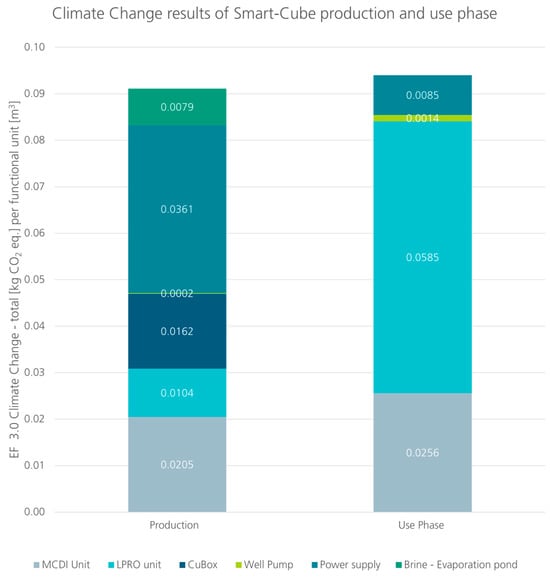
Figure 8.
Climate change results [EF 3.0 (kg CO2-eq.)] of Smart Cube production and use phase per functional unit [m3] over 30 years with 20 m3/day water demand for 350 days in a year.
In addition, the comparison of the desalination technologies (Figure 9) was performed with LPRO only, MCDI only, and LPRO + MCDI (equal amount of water throughput). Each technology option includes the power supply and the infrastructure. The water throughput and the groundwater depth were set as the base scenario. While the production phase is relatively similar, a closer look reveals that the impact of the use phase of the LPRO, and therefore the total CO2 emissions, is higher than that of the MCDI unit.
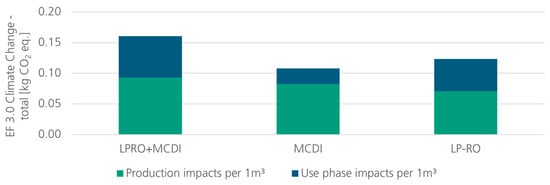
Figure 9.
Climate change results [EF 3.0 (kg CO2-eq.)] per 1 m3 of desalinated water over 30 years with 20 m3/day water demand for 350 days in a year in kg CO2-eq/m3.
3.2.2. LCA Results Scenario 2: Power Supply by Alternative Options
The baseline scenario of Smart Cube approach is further compared to the current Moroccan electricity grid and the alternative irrigation options impacts. The results show the high contrast of using electricity and delivery of water by truck instead of the Smart Cube (Figure 10). Due to heavy share of fossil fuels powered electricity [34], the impacts are 1689 and 1007 g CO2-eq. per m3 for LPRO and MCDI, respectively. For the fuel consumption of the diesel-powered trucks, each truck emits 1194 g CO2-eq. per m3 if the same amount of irrigation water was delivered over the lifetime of the Smart Cube (161 g CO2-eq./m3). For pumping purposes, using a diesel pump or LPG pump alone would have less impact than the Smart Cube. For an electricity-grid-powered pump, the impact results are higher, with higher CO2-eq. per m3 than the Smart Cube.
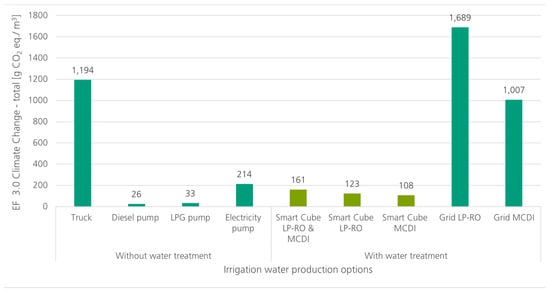
Figure 10.
Climate change results [EF 3.0 (kg CO2-eq.)] per 1 m3 production of irrigation water over 30 years with 20 m3/day water demand for 350 days in a year in kg CO2-eq/m3 (olive green: Smart Cube; green: alternative irrigation options).
3.3. Economic Impact Results
3.3.1. LCC Results Scenario 1: Baseline Scenario
Based on the results of the inventory analysis, the LPRO + PV unit has a lower total annual cost of EUR 4475 compared to the MCDI + PV, with a total annual cost of EUR 7473. A comparison of these results is shown in Figure 11. In terms of water produced per year, two different capacities were achieved by the systems depending on the salt removal target (33% and 66%). For 33% salt removal, the LPRO + PV system is able to produce 7546 m3/yr of irrigation water, while the MCDI + PV system produces 9912 m3/yr of irrigation water. When increasing the desalination target to 66% salt removal, both technologies have lower production (LPRO: 4881 m3/yr; MCDI: 6888 m3/yr) and higher energy consumption, which is expected due to the higher desalination grade. The results of the specific water costs are given in (Table 3).
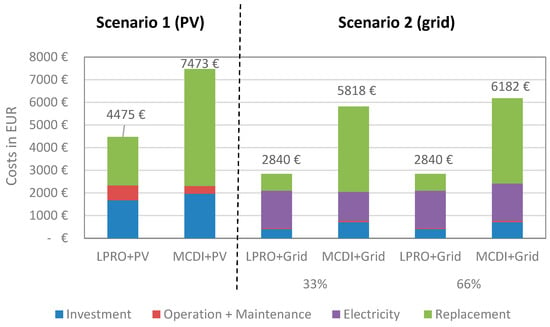
Figure 11.
Cost breakdown comparison to total costs of Scenario 1 (left) and Scenario 2 (right).

Table 3.
Desalination cost of 1 m3—Scenario 1.
Although the LPRO has a higher throughput than the MCDI, the higher total capacity (m3/day) of the MCDI is attributed to its higher water recovery and lower energy demand [13]. However, based on the cost of 1 m3 (Table 3), the LPRO is up to 28% less expensive than the MCDI for both options (33% and 66% salt removal) (at the lowest salt removal, 33%). Despite the lower maintenance costs and the relatively similar capital costs, the calculations show that the LPRO is more cost-effective in terms of cost per cubic meter of desalinated water produced. The main difference is due to the highest replacement cost of the MCDI, which significantly increases the annual cost.
3.3.2. LCC Results Scenario 2: Power Supply by Grid
In the analysis of this scenario, the systems are connected to the grid for power supply while the desalination capacity (m3/day) remains the same as that in Scenario 1.
The total annual costs are therefore calculated without the PV system and by adding the electricity costs based on the water production and specific energy consumption (SEC) values. The annual costs of the LPRO were lower than those of the MCDI in both options (33% and 66% salt removal) at EUR 2840. However, regarding energy consumption, the LPRO has a higher specific energy consumption (kWh/m3) compared to the MCDI.
Therefore, as in Scenario 1, the MCDI produces more water at both desalination rates, making it the preferred choice when high water production capacity is a priority. LPRO produces 7546 m3 (33%) and 4883 m3 of water (66%) compared to the MCDI, with 9912 m3 (33%) and 6888 m3 (66%) (Figure 11).
The results also indicate that, when using the grid, the prices are lower when connected to the Smart Cube (PV system). This is due to the very low energy prices of the Moroccan grid, which are calculated at EUR 0.10/kWh.With electricity prices already above EUR 0.20/kWh, using the PV system for the LPRO is more economical. For the MCDI, using the PV system is more economical at electricity prices above EUR 0.23/kWh (33%) and EUR 0.18 (66%) (Figure 11).
The results of specific water costs (Table 4) show that the cost per cubic meter of water produced differs depending on the configuration and the water production scenario. In addition, for both targets of salt removal, the LPRO connected to grid is significantly more cost-effective in terms of the cost per m3 of water produced compared to the MCDI connected to the grid, while offering higher water production capacity.

Table 4.
Desalination cost of 1 m3—Scenario 2.
3.4. Results LCA and LCC Scenario 3
A comparison of both the LCA and LCC results at different plant capacities (throughputs from 5 to 50 m3/day) is shown in Figure 12. The results show that both LPRO and MCDI technologies show cost reductions as the flow of desalinated water increases. In simple terms, producing more water per day makes desalination less expensive, which is an effect of upscaling. Optimum cost-effectiveness is achieved with a desalinated water flow of 40 m3/day, especially when using MCDI in conjunction with PV and aiming for a salt removal target of 33% (0.98 EUR/m3). At higher flow rates, the superior water recovery and reduced energy requirements of the MCDI outweigh its higher annual cost, enabling it to outperform the LPRO in terms of specific water cost. These results highlight the significant impact of scale in making water desalination economically efficient.
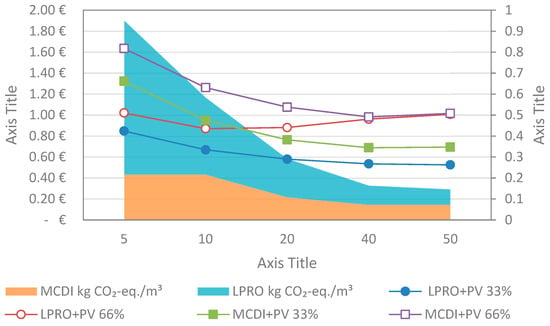
Figure 12.
Economic and environmental impact of MCDI and LPRO at throughputs from 5 to 50 m3/day.
The results of the environmental impacts of the LCA show the same results as the LCC results, with lower emissions after upscaling for both technologies. The results also show that the LPRO always has a higher overall environmental impact (production and use phase) compared to the MCDI, but the gap narrows as the water throughput increases (Figure 12).
4. Discussion
The Smart Cube approach is more economically feasible when water demand is higher, as shown by the LCA and LCC results. Comparing LPRO and MCDI, the LCC results show that LPRO operated with grid is the most cost-effective option for water desalination, regardless of the salinity reduction target (at 33% salinity reduction, LPRO costs EUR 2840 compared to EUR 5818 for MCDI). LPRO with PV is also cost effective, especially in Scenario 1, but becomes less competitive as the salt removal target increases (66%).
MCDI configurations, whether with a PV or the grid, generally result in higher costs, especially at the 66% salt removal target. There is also a similarity in price between LPRO with PV at 33% salt removal target and MCDI with grid (EUR 0.59/m3).
With increased plant capacity (Scenario 3), MCDI has lower specific costs at flows above 40–50 m3/day due to higher water recovery and lower specific energy consumption (SEC).
In terms of environmental impact, the LPRO has significantly more emissions than the MCDI due to the higher replacement and maintenance activity, especially from citric acid for CIP cleaning. However, the Smart Cube application with increased water throughput (more than 50 m3/day) would not make much difference between the two technologies.
In terms of power options, the use of the grid has a much higher contribution to the climate change results than the power from the PV system. If the desalination–irrigation system is to use the electricity grid, MCDI is a better option than LPRO in terms of GHG emissions.
When considering Life Cycle Assessment (LCA) and Life Cycle Cost Analysis (LCC), the right choice of system will depend on the specific farm conditions and farming practices, most importantly when considering the trade-offs between lower water prices and environmentally friendly irrigation.
5. Conclusions
In conclusion, our study investigated the LCA and LCC approaches to evaluate the environmental and economic impacts of two desalination technologies, LPRO and MCDI, integrated in a Smart Cube. Based on 1 m3 of desalinated water, different scenarios were discussed; the main results indicated that, for LCC, LPRO connected to the grid emerged as a more cost-effective option, although it requires more energy to produce desalinated water compared to MCDI. This was mainly attributed to the low energy prices of the Moroccan grid. MCDI connected to a photovoltaic (PV) system may be preferable for higher water production capacities, although this comes at a higher total cost.
In terms of environmental aspects, the LCA results showed that, under real conditions, LPRO had a significantly higher environmental impact than MCDI, which proves to be an environmentally friendly technology, especially when compared to conventional desalination methods. In particular, the grid-supplied option contributed significantly to the climate change category, mainly due to Morocco’s heavy reliance on fossil fuels for electricity generation.
These findings suggest that the selection of the appropriate desalination technology for sustainable agricultural practices in the Mediterranean region depends on specific local conditions (e.g., electricity costs) and must consider both economic and environmental factors. However, to achieve a sustainable system, the social aspect should also be considered.
Future research should focus on the integration of renewable energy with innovations in desalination technologies to achieve sustainable and cost-effective solutions for water scarcity in agriculture.
Supplementary Materials
The following supporting information can be downloaded at: https://www.mdpi.com/article/10.3390/su16041616/s1, Table S1: Questions for the current state of irrigation.
Author Contributions
Conceptualization, M.B.S., M.A. and E.E.C.K.; methodology M.B.S., E.E.C.K., S.-H.H. and C.S.; software, S.-H.H. and C.S.; validation, E.E.C.K., U.H., J.H. and M.A.; formal analysis, M.B.S., E.E.C.K. and M.A.; investigation, M.B.S. and E.E.C.K.; resources M.B.S., E.E.C.K., C.S. and S.-H.H.; data curation, E.E.C.K. and M.A.; writing—original draft preparation, M.B.S., E.E.C.K. and S.-H.H.; writing—review and editing, M.B.S., E.E.C.K., U.H. and S.-H.H.; visualization, M.B.S. and E.E.C.K.; supervision, M.A. and J.H. All authors have read and agreed to the published version of the manuscript.
Funding
This research was funded by the BMBF (Germany), DHESR (Morocco), FCT (Portugal) and MESRS (Tunisia) under the grant agreement number 01DH20005 and is part of the PRIMA programme supported and funded under Horizon 2020, the European Union’s Framework Programme for Research and Innovation. Project ID: 1522.
Informed Consent Statement
Informed consent was obtained from all subjects involved in the study.
Data Availability Statement
Data supporting reported results can be found at www.smacumed.eu, or provided upon request.
Conflicts of Interest
The authors declare no conflicts of interest.
Appendix A

Table A1.
LCC parameters of Smart Cube Scenario 1: total water production of MCDI and LPRO at salt removal of 33% and 66%. Based on average PV power production of max. 47 kWh/day, and assuming continuous production at the maximum net flow rates (max. 24 h/day); from [13].
Table A1.
LCC parameters of Smart Cube Scenario 1: total water production of MCDI and LPRO at salt removal of 33% and 66%. Based on average PV power production of max. 47 kWh/day, and assuming continuous production at the maximum net flow rates (max. 24 h/day); from [13].
| Operation Days | Total Water Production | SEC * | Net Flow |
|---|---|---|---|
| MCDI 33% | 28.32 m3/day | 1.3 kWh/m3 | 1.18 m3/h |
| LPRO 33% | 21.56 m3/day | 2.18 kWh/m3 | 2.9 m3/h |
| MCDI 66% | 19.68 m3/day | 2.37 kWh/m3 | 0.82 m3/h |
| LPRO 66% | 13.95 m3/day | 3.37 kWh/m3 | 1.8 m3/h |
* SEC: specific energy consumption.

Table A2.
LCA inventory analysis: mass balance of the Smart Cube units (MCDI, LPRO, Energy supply, infrastructure and evaporation ponds) and their components in kg.
Table A2.
LCA inventory analysis: mass balance of the Smart Cube units (MCDI, LPRO, Energy supply, infrastructure and evaporation ponds) and their components in kg.
| Membrane Capacitive Deionization (MCDI) Unit | 1029 | |||
|---|---|---|---|---|
| MCDI System | Model: Voltea IS12 | |||
| general components (screws, wires, valves) | 22.0 | |||
| aluminum metal frame | 220.0 | |||
| pre-filtration (sedimentation) | 2.3 | |||
| Pipes | 24.0 | |||
| CIP | 7.1 | |||
| Pump | 32.8 | |||
| electric cabinet | 173.0 | |||
| Sensors | 10.0 | |||
| MCDI Modules | C17 Voltea MCDI | |||
| external housing | 130.0 | |||
| silicone sealears and connectors | 57.0 | |||
| electrode (wires and material) | 135.0 | |||
| current collectors (graphite) | 136.0 | |||
| ion-exchange membranes | 30.0 | |||
| others | 50.0 | |||
| Low-Pressure Reverse Osmosis (LPRO) unit | 400 | |||
| LPRO System | Model: UO-PVC-2000 | |||
| general components (frame, valves, wires) | 201.4 | |||
| pre-filtration | 1.8 | |||
| CIP | 6.4 | |||
| Pumps | 84.8 | |||
| Sensors | 10.0 | |||
| pressure vessel | 66.0 | |||
| membrane modules | 30.0 | |||
| Energy Supply PV unit | 923 | |||
| PV Module | Suntech Power: STP405S-A72/Vnh | 428.0 | ||
| Invertor | SMA Solar Technology AG Sunny TriPower 6.0 | 17.0 | ||
| Battery | BYD B-Box Premium LVS 24.0 | 289.0 | ||
| Battery inverter | Sunny Island 6.0H | 189.0 | ||
| Smart Cube Infrastructure | 1495 | |||
| SmartCube Box | Model: HBT CuBox | |||
| metal frame (floor and ceiling) | 740.0 | |||
| doors | 472.0 | |||
| floor and ceiling (wood) | 283.0 | |||
| Well Pump | Model: Lowara 4Gs22M-L4C | 7.6 | ||
| Brine-collection system | 872 | |||
| Geomembrane | 879 m3 geomembrane, HDPE | 853.0 | ||
| pipes | PVC | 19.0 | ||
| Total Mass Smart Cube | 4719 | |||

Table A3.
LCC inventory water costs of LPRO, MCDI, and PV in EUR (divided between investment, replacement, and maintenance Costs).
Table A3.
LCC inventory water costs of LPRO, MCDI, and PV in EUR (divided between investment, replacement, and maintenance Costs).
| Costs | Category | Description | Qty. | Cost per Unit | Total Cost | Lifetime (Years) | Cost/yr |
|---|---|---|---|---|---|---|---|
| LPRO Unit | |||||||
| Investment (I) | RO- system | Model: UO-PVC-2000 | 12,375.00 | 30 | 412.50 | ||
| Replacement (Repl) | Module membranes | Membrane ESPA2-LD | 2 | 915 | 1830.00 | 5 | 366.00 |
| Booster pump | RO pump (2.2 kW) | 1 | 1660 | 1660.00 | 10 | 166.00 | |
| High pressure pump | 1 | 2100 | 2100.00 | 10 | 210.00 | ||
| Sum Repl. Costs | 742.00 | ||||||
| Maintenance (M) | Booster pump | RO pump (2.2 kW) | 83.00 | ||||
| High pressure pump | 105.00 | ||||||
| Filter cartridge | 30.00 | ||||||
| Sensors | 20.00 | ||||||
| CIP: Citric acid | 320.00 | ||||||
| Labor | control, cleaning, replacements | 0.5 | h/week | 1.56 (EUR/h) | 40.43 | ||
| Sum OPEX | 598.00 | ||||||
| MCDI Unit | |||||||
| Investment (I) | MCDI System IS12 | Model: Voltea IS12 | 21,165.00 | 30 | 705.50 | ||
| Replacement (Repl) | MCDI Pump | MCDI feed pump | 1 | 1660.00 | 10 | 166.00 | |
| MCDI Modules | C17 electrode | 12 | 1500.00 | 18,000.00 | 5 | 3600.00 | |
| Sum Repl. Costs | 3766.00 | ||||||
| Maintenance (M) | MCDI Pump | MCDI feed pump | 83.00 | ||||
| Filter cartridge | 16.00 | ||||||
| Sensors | 20.00 | ||||||
| CIP: Citric acid | 80.00 | ||||||
| Labor | control, cleaning, replacements | 1 | h/week | 1.56 (EUR/h) | 80.86 | ||
| Sum OPEX | 279.86 | ||||||
| Photovoltaic Unit | |||||||
| Investement (I) | Photovoltaic system | 37,842.00 | 30 | 1261.40 | |||
| Replacement costs (Repl) | Solar panel (PV) | BYD Battery-Box Premium | 1 | 12,787.00 | 12,787.00 | 15 | 852.47 |
| Battery inverter | 3 | 2306.40 | 6919.20 | 15 | 461.28 | ||
| Three-phase PV inverter | 1 | 1335.50 | 1335.50 | 15 | 89.03 | ||
| Sum Repl. Costs | 1402.78 | ||||||
| Maintenance (M) | Cleaning PV | cleaning with water | 2 | h/month | 1.56 (EUR/h) | 37.32 | |
| Labor | control, replacements | 0.25 | h/week | 1.56 (EUR/h) | 20.22 | ||
| Sum OPEX | 20.22 | ||||||
Investment costs from actual purchase prices in EUR (2020–2021). Replacement costs 5–10% from purchase value. Maintenance costs from experience during pilot trials (cleaning in place (CIP); chemicals used—citric acid; repairs (e.g., broken pipes, valves); pump maintenance, etc.). Additional CIP of MCDI with pressurized air not included.

Table A4.
Repairs and maintenance frequency of the Smart Cube.
Table A4.
Repairs and maintenance frequency of the Smart Cube.
| Unit | Sub-Component | Quantity | Maintenance/ Replacements Frequency (Years) |
|---|---|---|---|
| LPRO | LPRO Pump | 1piece | 10 |
| LPRO Membrane | 2 pieces | 4 | |
| Filter Cartridge | 1 piece | 0.5 | |
| Citric Acid | 20 kg | 0.5 | |
| MCDI | MCDI Pump | 1 piece | 10 |
| Filter Cartridge | 1 piece | 0.5 | |
| MCDI Modules | 12 pieces | 5 | |
| Citric Acid | 5 kg | 0.5 | |
| PV System | Battery Smart Cube | 1 piece | 15 |
| Battery Inverter | 1 piece | 15 | |
| PV Inverter | 1 piece | 15 | |
| PV Panels | 1 piece | 30 |

Table A5.
Energy consumption from different groundwater extraction pumps for the baseline scenario.
Table A5.
Energy consumption from different groundwater extraction pumps for the baseline scenario.
| Energy Consumption (kWh/Yr) | Amount (L/Yr) | Amount (L/m3 Water) | |
|---|---|---|---|
| Diesel consumed | 3873 | 396 | 0.057 |
| LPG consumed | 3873 | 544 | 0.078 |
| Butane gas consumed | 3873 | 484 | 0.069 |
| Electricity grid mix | 1937 | - |
References
- Liu, J.; Yang, H.; Gosling, S.N.; Kummu, M.; Flörke, M.; Pfister, S.; Hanasaki, N.; Wada, Y.; Zhang, X.; Zheng, C.; et al. Water Scarcity Assessments in the Past, Present, and Future. Earth’s Future 2017, 5, 545–559. [Google Scholar] [CrossRef]
- He, C.; Liu, Z.; Wu, J.; Pan, X.; Fang, Z.; Li, J.; Bryan, B.A. Future Global Urban Water Scarcity and Potential Solutions. Nat. Commun. 2021, 12, 4667. [Google Scholar] [CrossRef]
- Mehmeti, A.; Canaj, K. Environmental Assessment of Wastewater Treatment and Reuse for Irrigation: A Mini-Review of LCA Studies. Resources 2022, 11, 94. [Google Scholar] [CrossRef]
- Touil, S.; Richa, A.; Fizir, M.; Argente García, J.E.; Skarmeta Gómez, A.F. A Review on Smart Irrigation Management Strategies and Their Effect on Water Savings and Crop Yield. Irrig. Drain. 2022, 71, 1396–1416. [Google Scholar] [CrossRef]
- Raluy, R.G.; Serra, L.; Uche, J. Life Cycle Assessment of Desalination Technologies Integrated with Renewable Energies. Desalination 2005, 183, 81–93. [Google Scholar] [CrossRef]
- Tzanakakis, V.A.; Paranychianakis, N.V.; Angelakis, A.N. Water Supply and Water Scarcity. Water 2020, 12, 2347. [Google Scholar] [CrossRef]
- Kumar Sahu, C.; Behera, P. A Low Cost Smart Irrigation Control System. In Proceedings of the 2015 2nd International Conference on Electronics and Communication Systems (ICECS), Coimbatore, India, 26–27 February 2015; pp. 1146–1151. [Google Scholar] [CrossRef]
- Al Jabri, S.A.; Zekri, S.; Zarzoc, D.; Ahmed, M. Comparative Analysis of Economic and Institutional Aspects of Desalination for Agriculture in the Sultanate of Oman and Spain. Desalination Water Treat. 2019, 156, 1–6. [Google Scholar] [CrossRef]
- Curto, D.; Franzitta, V.; Guercio, A. A Review of the Water Desalination Technologies. Appl. Sci. 2021, 11, 670. [Google Scholar] [CrossRef]
- Burn, S.; Hoang, M.; Zarzo, D.; Olewniak, F.; Campos, E.; Bolto, B.; Barron, O. Desalination Techniques—A Review of the Opportunities for Desalination in Agriculture. Desalination 2015, 364, 2–16. [Google Scholar] [CrossRef]
- Kumar, A.; Ranjan, P.; Saini, V. Smart Irrigation System Using IoT. Adv. Ser. Manag. 2022, 27, 123–139. [Google Scholar] [CrossRef]
- Mehdaoui, R.; Anane, M.; Kurz, E.E.C.; Hellriegel, U.; Hoinkis, J. Geospatial Multi-Criteria Approach for Ranking Suitable Shallow Aquifers for the Implementation of an On-Farm Solar-PV Desalination System for Sustainable Agriculture. Sustainability 2022, 14, 8113. [Google Scholar] [CrossRef]
- Kurz, E.E.C.; Hellriegel, U.; Hdoufane, A.; Benaceur, I.; Anane, M.; Jaiti, F.; El-abbassi, A.; Hoinkis, J. Comparison of Pilot-Scale Capacitive Deionization (MCDI) and Low-Pressure Reverse Osmosis (LPRO) for PV-Powered Brackish Water Desalination in Morocco for Irrigation of Argan Trees. Membranes 2023, 13, 668. [Google Scholar] [CrossRef]
- AlMarzooqi, F.A.; Al Ghaferi, A.A.; Saadat, I.; Hilal, N. Application of Capacitive Deionisation in Water Desalination: A Review. Desalination 2014, 342, 3–15. [Google Scholar] [CrossRef]
- Qasim, M.; Badrelzaman, M.; Darwish, N.N.; Darwish, N.A.; Hilal, N. Reverse osmosis desalination: A state-of-the-art review. Desalination 2019, 459, 59–104. [Google Scholar] [CrossRef]
- Skuse, C.; Gallego-Schmid, A.; Azapagic, A.; Gorgojo, P. Can Emerging Membrane-Based Desalination Technologies Replace Reverse Osmosis? Desalination 2021, 500, 114844. [Google Scholar] [CrossRef]
- Zhou, J.; Chang, V.W.C.; Fane, A.G. Life Cycle Assessment for Desalination: A Review on Methodology Feasibility and Reliability. Water Res. 2014, 61, 210–223. [Google Scholar] [CrossRef]
- Lopsik, K. Life Cycle Assessment of Small-Scale Constructed Wetland and Extended Aeration Activated Sludge Wastewater Treatment System. Int. J. Environ. Sci. Technol. 2013, 10, 1295–1308. [Google Scholar] [CrossRef]
- Yousfi, A.; Poirier, E.A.; Forgues, D. Exploring the Synergies between Life Cycle Cost/Whole Life Cost and Building Information Modeling: A Systematic Literature Review. IOP Conf. Ser. Earth Environ. Sci. 2022, 1101, 052011. [Google Scholar] [CrossRef]
- Degieter, M.; Gellynck, X.; Goyal, S.; Ott, D.; De Steur, H. Life Cycle Cost Analysis of Agri-Food Products: A Systematic Review. Sci. Total Environ. 2022, 850, 158012. [Google Scholar] [CrossRef] [PubMed]
- Kawauchi, Y.; Cooperation, T.E.; Rausand, M. Life Cycle Cost (LCC) Analysis in Oil and Chemical Process Industries Life Cycle Cost (LCC) Analysis in Oil and Chemical Process Industries. ResearchGate 2014. [Google Scholar]
- Yu, T.H.; Shiu, H.Y.; Lee, M.; Chiueh, P.T.; Hou, C.H. Life Cycle Assessment of Environmental Impacts and Energy Demand for Capacitive Deionization Technology. Desalination 2016, 399, 53–60. [Google Scholar] [CrossRef]
- Shiu, H.Y.; Lee, M.; Chao, Y.; Chang, K.C.; Hou, C.H.; Chiueh, P. Te Hotspot Analysis and Improvement Schemes for Capacitive Deionization (CDI) Using Life Cycle Assessment. Desalination 2019, 468, 114087. [Google Scholar] [CrossRef]
- Çetinkaya, A.Y. Life Cycle Assessment of Environmental Effects and Nitrate Removal for Membrane Capacitive Deionization Technology. Environ. Monit. Assess. 2020, 192, 1–8. [Google Scholar] [CrossRef] [PubMed]
- Shahabi, M.P.; McHugh, A.; Anda, M.; Ho, G. Environmental Life Cycle Assessment of Seawater Reverse Osmosis Desalination Plant Powered by Renewable Energy. Renew. Energy 2014, 67, 53–58. [Google Scholar] [CrossRef]
- Cetinkaya, A.Y.; Bilgili, L. Life Cycle Comparison of Membrane Capacitive Deionization and Reverse Osmosis Membrane for Textile Wastewater Treatment. Water Air Soil Pollut. 2019, 230, 149. [Google Scholar] [CrossRef]
- Bales, C.; Lian, B.; Fletcher, J.; Wang, Y.; Waite, T.D. Site Specific Assessment of the Viability of Membrane Capacitive Deionization (MCDI) in Desalination of Brackish Groundwaters for Selected Crop Watering. Desalination 2021, 502, 114913. [Google Scholar] [CrossRef]
- Shokri, A.; Sanavi Fard, M. Techno-Economic Assessment of Water Desalination: Future Outlooks and Challenges. Process Saf. Environ. Prot. 2023, 169, 564–578. [Google Scholar] [CrossRef]
- Côté, P.; Siverns, S.; Monti, S. Comparison of Membrane-Based Solutions for Water Reclamation and Desalination. Desalination 2005, 182, 251–257. [Google Scholar] [CrossRef]
- Lu, K.; Jiang, X.; Yu, J.; Tam, V.W.Y.; Skitmore, M. Integration of Life Cycle Assessment and Life Cycle Cost Using Building Information Modeling: A Critical Review. J. Clean. Prod. 2021, 285, 125438. [Google Scholar] [CrossRef]
- Chau, C.K.; Leung, T.M.; Ng, W.Y. A Review on Life Cycle Assessment, Life Cycle Energy Assessment and Life Cycle Carbon Emissions Assessment on Buildings. Appl. Energy 2015, 143, 395–413. [Google Scholar] [CrossRef]
- European Commission: Recommendation on the Use of Environmental Footprint Methods; Directorate-General for Environment. Available online: Https://Environment.Ec.Europa.Eu/Publications/Recommendation-Use-Environmental-Footprint-Methods_en (accessed on 16 December 2021).
- Do Thi, H.T.; Tóth, A.J. Investigation of Carbon Footprints of Three Desalination Technologies: Reverse Osmosis (RO), Multi-Stage Flash Distillation (MSF) and Multi-Effect Distillation (MED). Period. Polytech. Chem. Eng. 2023, 67, 41–48. [Google Scholar] [CrossRef]
- IRENA Energy Profile. IUPAC Compend. Chem. Terminol. 2008. [CrossRef]
- European Commission: Implementing Directive 2009/125/EC of the European Parliament and of the Council with Regard to Ecodesign Requirements for Water Pumps. Available online: http://data.europa.eu/eli/reg/2012/547/oj (accessed on 7 January 2024).
Disclaimer/Publisher’s Note: The statements, opinions and data contained in all publications are solely those of the individual author(s) and contributor(s) and not of MDPI and/or the editor(s). MDPI and/or the editor(s) disclaim responsibility for any injury to people or property resulting from any ideas, methods, instructions or products referred to in the content. |
© 2024 by the authors. Licensee MDPI, Basel, Switzerland. This article is an open access article distributed under the terms and conditions of the Creative Commons Attribution (CC BY) license (https://creativecommons.org/licenses/by/4.0/).